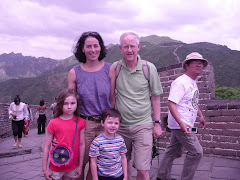The Fukagawa Edo Museum, which is an old-style neighborhood, is very modern on the outside - a typically enormous concrete structure.

But inside there's a reconstructed, 19th-century riverside neighborhood. Here's a drawing of the concept and what you find after paying an entrance fee of 300 yen ($3) for adults and 50 yen (50 cents) for children.


There were a few elderly Japanese who worked, or volunteered, in the museum, sort of like greeters at Wal-Mart. One woman silently followed us around - like a "minder" in a Communist country - to make sure that Lucinda and Sylvan (two very responsible kindergarteners) didn't wreck anything. But an elderly man, who spoke very good English, more generously explained what we were looking at. (Forgive the dim pix; the light in the museum changed day-to-night-to-day, etc., also somewhat annoying.)
Edo neighborhoods like this one were mainly occupied by young, single laborers or married men whose wives were in the country. The names of the inhabitants are listed on a board above the gate leading to a small boarding house and other dwellings, as a security measure to keep strangers out.

In the boarding house, each laborer lived in a single room that was smaller than our current kitchen. The floors are tatami mats, the sleeping futons are folded in the corner (back left in the photo) during the day. Each has a tiny kitchen and a small portable table or tray to serve and eat on.

Sometimes there were rice-straw "raincoats" and hats hanging inside the door, and tiny sandals by the door.


There was a produce store (top) and a rice store (bottom), with big foot-levers to smash the rice into paste, or "mochi."


Also available for viewing: a water taxi to take laborers elsewhere to have a little fun, and a "fire tower" where residents would check for smoke every hour, because a moderate fire would wipe out the whole place in minutes. And a public square with a shack to sell "yakitori" or grilled seafood and veggies.


It was fun and interesting - if restrained. After our visit, we found a local restaurant for noodles, rice and tempura, and sat at traditional low-to-ground Japanese tables, very in-tune with our museum visit.


No comments:
Post a Comment